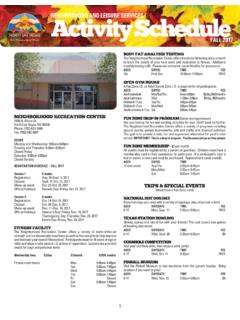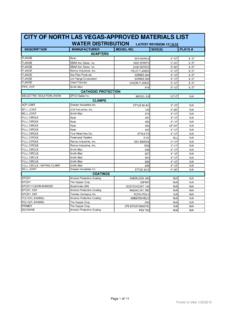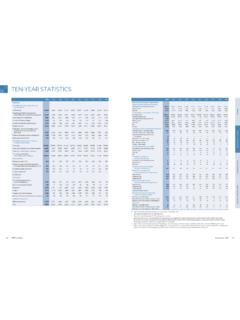Transcription of arXiv:1508.01211v2 [cs.CL] 20 Aug 2015
1 Listen, Attend and Spell William Chan Navdeep Jaitly, Quoc V. Le, Oriol Vinyals Carnegie Mellon University Google Brain [ ] 20 Aug 2015. Abstract We present Listen, Attend and Spell (LAS), a neural network that learns to tran- scribe speech utterances to characters. Unlike traditional DNN-HMM models, this model learns all the components of a speech recognizer jointly. Our system has two components: a listener and a speller. The listener is a pyramidal recurrent net- work encoder that accepts filter bank spectra as inputs. The speller is an attention- based recurrent network decoder that emits characters as outputs. The network produces character sequences without making any independence assumptions be- tween the characters. This is the key improvement of LAS over previous end-to- end CTC models.
2 On a subset of the Google voice search task, LAS achieves a word error rate (WER) of without a dictionary or a language model, and with language model rescoring over the top 32 beams. By comparison, the state-of-the-art CLDNN-HMM model achieves a WER of 1 Introduction Deep Neural Networks (DNNs) have led to improvements in various components of speech recog- nizers. They are commonly used in hybrid DNN-HMM speech recognition systems for acoustic modeling [1, 2, 3, 4, 5, 6]. DNNs have also produced significant gains in pronunciation models that map words to phoneme sequences [7, 8]. In language modeling, recurrent models have been shown to improve speech recognition accuracy by rescoring n-best lists [9]. Traditionally these compo- nents acoustic, pronunciation and language models have all been trained separately, each with a different objective.
3 Recent work in this area attempts to rectify this disjoint training issue by design- ing models that are trained end-to-end from speech directly to transcripts [10, 11, 12, 13, 14, 15]. Two main approaches for this are Connectionist Temporal Classification (CTC) [10] and sequence to sequence models with attention [16]. Both of these approaches have limitations that we try to address: CTC assumes that the label outputs are conditionally independent of each other; whereas the sequence to sequence approach has only been applied to phoneme sequences [14, 15], and not trained end-to-end for speech recognition. In this paper we introduce Listen, Attend and Spell (LAS), a neural network that improves upon the previous attempts [12, 14, 15].
4 The network learns to transcribe an audio sequence signal to a word sequence, one character at a time. Unlike previous approaches, LAS does not make independence assumptions in the label sequence and it does not rely on HMMs. LAS is based on the sequence to sequence learning framework with attention [17, 18, 16, 14, 15]. It consists of an encoder recurrent neural network (RNN), which is named the listener, and a decoder RNN, which is named the speller. The listener is a pyramidal RNN that converts low level speech signals into higher level features. The speller is an RNN that converts these higher level features into output utterances by specifying a probability distribution over sequences of characters using the attention mechanism [16, 14, 15].
5 The listener and the speller are trained jointly. Key to our approach is the fact that we use a pyramidal RNN model for the listener, which reduces the number of time steps that the attention model has to extract relevant information from. Rare and out-of-vocabulary (OOV) words are handled automatically, since the model outputs the character 1. sequence, one character at a time. Another advantage of modeling characters as outputs is that the network is able to generate multiple spelling variants naturally. For example, for the phrase triple a . the model produces both triple a and aaa in the top beams (see section ). A model like CTC. may have trouble producing such diverse transcripts for the same utterance because of conditional independence assumptions between frames.
6 In our experiments, we find that these components are necessary for LAS to work well. Without the attention mechanism, the model overfits the training data significantly, in spite of our large training set of three million utterances - it memorizes the training transcripts without paying attention to the acoustics. Without the pyramid structure in the encoder side, our model converges too slowly - even after a month of training, the error rates were significantly higher than the errors we report here. Both of these problems arise because the acoustic signals can have hundreds to thousands of frames which makes it difficult to train the RNNs. Finally, to reduce the overfitting of the speller to the training transcripts, we use a sampling trick during training [19].
7 With these improvements, LAS achieves WER on a subset of the Google voice search task, without a dictionary or a language model. When combined with language model rescoring, LAS. achieves WER. By comparison, the Google state-of-the-art CLDNN-HMM system achieves WER on the same data set [20]. 2 Related Work Even though deep networks have been successfully used in many applications, until recently, they have mainly been used in classification: mapping a fixed-length vector to an output category [21]. For structured problems, such as mapping one variable-length sequence to another variable-length sequence, neural networks have to be combined with other sequential models such as Hidden Markov Models (HMMs) [22] and Conditional Random Fields (CRFs) [23].
8 A drawback of this combining approach is that the resulting models cannot be easily trained end-to-end and they make simplistic assumptions about the probability distribution of the data. Sequence to sequence learning is a framework that attempts to address the problem of learning variable-length input and output sequences [17]. It uses an encoder RNN to map the sequential variable-length input into a fixed-length vector. A decoder RNN then uses this vector to produce the variable-length output sequence, one token at a time. During training, the model feeds the groundtruth labels as inputs to the decoder. During inference, the model performs a beam search to generate suitable candidates for next step predictions. Sequence to sequence models can be improved significantly by the use of an attention mechanism that provides the decoder RNN more information when it produces the output tokens [16].
9 At each output step, the last hidden state of the decoder RNN is used to generate an attention vector over the input sequence of the encoder. The attention vector is used to propagate information from the encoder to the decoder at every time step, instead of just once, as with the original sequence to sequence model [17]. This attention vector can be thought of as skip connections that allow the information and the gradients to flow more effectively in an RNN. The sequence to sequence framework has been used extensively for many applications: machine translation [24, 25], image captioning [26, 27], parsing [28] and conversational modeling [29]. The generality of this framework suggests that speech recognition can also be a direct application [14, 15].
10 3 Model In this section, we will formally describe LAS which accepts acoustic features as in- puts and emits English characters as outputs. Let x = (x1 , .. , xT ) be our input se- quence of filter bank spectra features, and let y = (hsosi, y1 , .. , yS , heosi), yi . {a, b, c, , z, 0, , 9, hspacei, hcommai, hperiodi, hapostrophei, hunki}, be the output se- quence of characters. Here hsosi and heosi are the special start-of-sentence token, and end-of- sentence tokens, respectively. 2. We want to model each character output yi as a conditional distribution over the previous characters y<i and the input signal x using the chain rule: Y. P (y|x) = P (yi |x, y<i ) (1). i Our Listen, Attend and Spell (LAS) model consists of two sub-modules: the listener and the speller.
![arXiv:0706.3639v1 [cs.AI] 25 Jun 2007](/cache/preview/4/1/3/9/3/1/4/b/thumb-4139314b93ef86b7b4c2d05ebcc88e46.jpg)

![arXiv:1301.3781v3 [cs.CL] 7 Sep 2013](/cache/preview/4/d/5/0/4/3/4/0/thumb-4d504340120163c0bdf3f4678d8d217f.jpg)
![@google.com arXiv:1609.03499v2 [cs.SD] 19 Sep 2016](/cache/preview/c/3/4/9/4/6/9/b/thumb-c349469b499107d21e221f2ac908f8b2.jpg)











